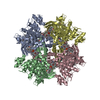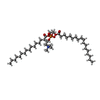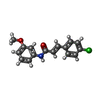[English] 日本語
 Yorodumi
Yorodumi- PDB-8gfa: Cryo-EM structure of human TRPV1 in complex with the analgesic dr... -
+ Open data
Open data
- Basic information
Basic information
| Entry | Database: PDB / ID: 8gfa | ||||||||||||||||||
|---|---|---|---|---|---|---|---|---|---|---|---|---|---|---|---|---|---|---|---|
| Title | Cryo-EM structure of human TRPV1 in complex with the analgesic drug SB-366791 | ||||||||||||||||||
 Components Components | Transient receptor potential cation channel subfamily V member 1 | ||||||||||||||||||
 Keywords Keywords | MEMBRANE PROTEIN / transient receptor potential V family member 1 / TRP / human / channel / inhibition / antagonist / TRPV1 / TRP channels / pain / analgesic / drug / SB-366791 / thermo-TRP / temperature sensation / vanilloid / GDN / detergent / glyco-diosgenin | ||||||||||||||||||
| Function / homology |  Function and homology information Function and homology informationchemosensory behavior / response to capsazepine / sensory perception of mechanical stimulus / peptide secretion / excitatory extracellular ligand-gated monoatomic ion channel activity / temperature-gated ion channel activity / detection of chemical stimulus involved in sensory perception of pain / smooth muscle contraction involved in micturition / fever generation / detection of temperature stimulus involved in thermoception ...chemosensory behavior / response to capsazepine / sensory perception of mechanical stimulus / peptide secretion / excitatory extracellular ligand-gated monoatomic ion channel activity / temperature-gated ion channel activity / detection of chemical stimulus involved in sensory perception of pain / smooth muscle contraction involved in micturition / fever generation / detection of temperature stimulus involved in thermoception / thermoception / cellular response to acidic pH / dendritic spine membrane / TRP channels / diet induced thermogenesis / cellular response to alkaloid / cellular response to ATP / detection of temperature stimulus involved in sensory perception of pain / intracellularly gated calcium channel activity / behavioral response to pain / calcium ion import across plasma membrane / voltage-gated calcium channel activity / extracellular ligand-gated monoatomic ion channel activity / phosphatidylinositol binding / phosphoprotein binding / calcium ion transmembrane transport / GABA-ergic synapse / lipid metabolic process / calcium channel activity / transmembrane signaling receptor activity / sensory perception of taste / cellular response to heat / protein homotetramerization / postsynaptic membrane / calmodulin binding / cell surface receptor signaling pathway / negative regulation of transcription by RNA polymerase II / ATP binding / metal ion binding / membrane / plasma membrane Similarity search - Function | ||||||||||||||||||
| Biological species |  Homo sapiens (human) Homo sapiens (human) | ||||||||||||||||||
| Method | ELECTRON MICROSCOPY / single particle reconstruction / cryo EM / Resolution: 2.29 Å | ||||||||||||||||||
 Authors Authors | Neuberger, A. / Nadezhdin, K.D. / Sobolevsky, A.I. | ||||||||||||||||||
| Funding support |  United States, United States,  Germany, 5items Germany, 5items
| ||||||||||||||||||
 Citation Citation |  Journal: Nat Commun / Year: 2023 Journal: Nat Commun / Year: 2023Title: Human TRPV1 structure and inhibition by the analgesic SB-366791. Authors: Arthur Neuberger / Mai Oda / Yury A Nikolaev / Kirill D Nadezhdin / Elena O Gracheva / Sviatoslav N Bagriantsev / Alexander I Sobolevsky /  Abstract: Pain therapy has remained conceptually stagnant since the opioid crisis, which highlighted the dangers of treating pain with opioids. An alternative addiction-free strategy to conventional painkiller- ...Pain therapy has remained conceptually stagnant since the opioid crisis, which highlighted the dangers of treating pain with opioids. An alternative addiction-free strategy to conventional painkiller-based treatment is targeting receptors at the origin of the pain pathway, such as transient receptor potential (TRP) ion channels. Thus, a founding member of the vanilloid subfamily of TRP channels, TRPV1, represents one of the most sought-after pain therapy targets. The need for selective TRPV1 inhibitors extends beyond pain treatment, to other diseases associated with this channel, including psychiatric disorders. Here we report the cryo-electron microscopy structures of human TRPV1 in the apo state and in complex with the TRPV1-specific nanomolar-affinity analgesic antagonist SB-366791. SB-366791 binds to the vanilloid site and acts as an allosteric hTRPV1 inhibitor. SB-366791 binding site is supported by mutagenesis combined with electrophysiological recordings and can be further explored to design new drugs targeting TRPV1 in disease conditions. | ||||||||||||||||||
| History |
|
- Structure visualization
Structure visualization
| Structure viewer | Molecule:  Molmil Molmil Jmol/JSmol Jmol/JSmol |
|---|
- Downloads & links
Downloads & links
- Download
Download
| PDBx/mmCIF format |  8gfa.cif.gz 8gfa.cif.gz | 863.1 KB | Display |  PDBx/mmCIF format PDBx/mmCIF format |
|---|---|---|---|---|
| PDB format |  pdb8gfa.ent.gz pdb8gfa.ent.gz | 716.8 KB | Display |  PDB format PDB format |
| PDBx/mmJSON format |  8gfa.json.gz 8gfa.json.gz | Tree view |  PDBx/mmJSON format PDBx/mmJSON format | |
| Others |  Other downloads Other downloads |
-Validation report
| Summary document |  8gfa_validation.pdf.gz 8gfa_validation.pdf.gz | 2.2 MB | Display |  wwPDB validaton report wwPDB validaton report |
|---|---|---|---|---|
| Full document |  8gfa_full_validation.pdf.gz 8gfa_full_validation.pdf.gz | 2.3 MB | Display | |
| Data in XML |  8gfa_validation.xml.gz 8gfa_validation.xml.gz | 85 KB | Display | |
| Data in CIF |  8gfa_validation.cif.gz 8gfa_validation.cif.gz | 115.4 KB | Display | |
| Arichive directory |  https://data.pdbj.org/pub/pdb/validation_reports/gf/8gfa https://data.pdbj.org/pub/pdb/validation_reports/gf/8gfa ftp://data.pdbj.org/pub/pdb/validation_reports/gf/8gfa ftp://data.pdbj.org/pub/pdb/validation_reports/gf/8gfa | HTTPS FTP |
-Related structure data
| Related structure data |  29983MC  8gf8C  8gf9C C: citing same article ( M: map data used to model this data |
|---|---|
| Similar structure data | Similarity search - Function & homology  F&H Search F&H Search |
- Links
Links
- Assembly
Assembly
| Deposited unit | 
|
|---|---|
| 1 |
|
- Components
Components
-Protein , 1 types, 4 molecules ABCD
| #1: Protein | Mass: 124575.281 Da / Num. of mol.: 4 Source method: isolated from a genetically manipulated source Source: (gene. exp.)  Homo sapiens (human) / Gene: TRPV1, VR1 / Plasmid: pEG BacMam / Cell line (production host): HEK293 / Production host: Homo sapiens (human) / Gene: TRPV1, VR1 / Plasmid: pEG BacMam / Cell line (production host): HEK293 / Production host:  Homo sapiens (human) / Variant (production host): suspension-adapted cells / References: UniProt: Q8NER1 Homo sapiens (human) / Variant (production host): suspension-adapted cells / References: UniProt: Q8NER1 |
|---|
-Non-polymers , 5 types, 151 molecules 








| #2: Chemical | ChemComp-POV / ( #3: Chemical | ChemComp-ZEI / ( #4: Chemical | ChemComp-DU0 / #5: Chemical | #6: Water | ChemComp-HOH / | |
|---|
-Details
| Has ligand of interest | Y |
|---|---|
| Has protein modification | Y |
-Experimental details
-Experiment
| Experiment | Method: ELECTRON MICROSCOPY |
|---|---|
| EM experiment | Aggregation state: PARTICLE / 3D reconstruction method: single particle reconstruction |
- Sample preparation
Sample preparation
| Component | Name: sample 1 / Type: COMPLEX / Entity ID: #1 / Source: RECOMBINANT | ||||||||||||||||||||||||||||||
|---|---|---|---|---|---|---|---|---|---|---|---|---|---|---|---|---|---|---|---|---|---|---|---|---|---|---|---|---|---|---|---|
| Molecular weight | Value: 0.09497 MDa / Experimental value: NO | ||||||||||||||||||||||||||||||
| Source (natural) | Organism:  Homo sapiens (human) Homo sapiens (human) | ||||||||||||||||||||||||||||||
| Source (recombinant) | Organism:  Homo sapiens (human) / Cell: Human embryonic kidney 293 / Plasmid: pEG BacMam Homo sapiens (human) / Cell: Human embryonic kidney 293 / Plasmid: pEG BacMam | ||||||||||||||||||||||||||||||
| Buffer solution | pH: 8 | ||||||||||||||||||||||||||||||
| Buffer component |
| ||||||||||||||||||||||||||||||
| Specimen | Conc.: 3 mg/ml / Embedding applied: NO / Shadowing applied: NO / Staining applied: NO / Vitrification applied: YES / Details: human TRPV1 | ||||||||||||||||||||||||||||||
| Specimen support | Grid material: GOLD / Grid mesh size: 300 divisions/in. / Grid type: UltrAuFoil R1.2/1.3 | ||||||||||||||||||||||||||||||
| Vitrification | Instrument: FEI VITROBOT MARK IV / Cryogen name: ETHANE / Humidity: 100 % / Chamber temperature: 277 K |
- Electron microscopy imaging
Electron microscopy imaging
| Experimental equipment |  Model: Titan Krios / Image courtesy: FEI Company |
|---|---|
| Microscopy | Model: TFS KRIOS |
| Electron gun | Electron source:  FIELD EMISSION GUN / Accelerating voltage: 300 kV / Illumination mode: FLOOD BEAM FIELD EMISSION GUN / Accelerating voltage: 300 kV / Illumination mode: FLOOD BEAM |
| Electron lens | Mode: BRIGHT FIELD / Nominal defocus max: 1500 nm / Nominal defocus min: 750 nm / Cs: 2.7 mm |
| Image recording | Average exposure time: 1.87 sec. / Electron dose: 60 e/Å2 / Film or detector model: GATAN K3 (6k x 4k) / Num. of grids imaged: 1 / Num. of real images: 4188 |
| Image scans | Width: 5760 / Height: 4092 |
- Processing
Processing
| EM software |
| ||||||||||||||||||||||||||||||||||||
|---|---|---|---|---|---|---|---|---|---|---|---|---|---|---|---|---|---|---|---|---|---|---|---|---|---|---|---|---|---|---|---|---|---|---|---|---|---|
| CTF correction | Type: NONE | ||||||||||||||||||||||||||||||||||||
| Particle selection | Num. of particles selected: 1988636 | ||||||||||||||||||||||||||||||||||||
| 3D reconstruction | Resolution: 2.29 Å / Resolution method: FSC 0.143 CUT-OFF / Num. of particles: 67470 / Symmetry type: POINT | ||||||||||||||||||||||||||||||||||||
| Atomic model building | Space: REAL | ||||||||||||||||||||||||||||||||||||
| Refine LS restraints |
|
 Movie
Movie Controller
Controller




 PDBj
PDBj





